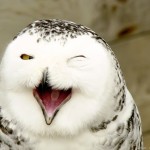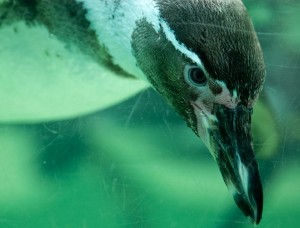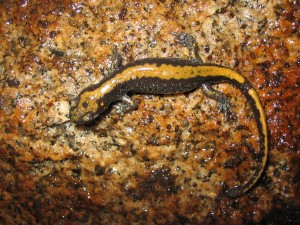by Kristen Minogue
Sometimes Mother Nature completely outdoes anything we’ve created for ourselves. Accomplishments like the Agricultural and Industrial Revolutions can seem almost laughable when there are lizards that can walk on water. When that happens, smart engineers try to take a lesson from it. It’s called biomimicry: technology inspired by nature. Examples include gecko tape, shape-shifting airplane wings and Velcro©. Last week a group of teenage students in SERC’s home-school program finished their own research on animal physiology and brought a few more examples to our attention. Here are four ways birds and amphibians outclass humanity – and some wacky yet brilliant ways we can mimic them.Water-repellant coats that actually repel water (Samuel Enriquez) Human attempts to make waterproof clothes have a few drawbacks. They can become saturated. They can be uncomfortable to wear. The water can linger on the outside, making them awkward to store (picture the sea of umbrellas that pile up in an office lobby during a rainstorm). Birds have a slightly better system worked out. Instead of absorbing or blocking water, their feathers deflect it. Tiny barbs on the surface of pigeon feathers force water droplets to bounce off. Granted, recreating the fine detail of a spiked feather could be a bit more difficult than making an oilskin coat. But picture the irritating front-door obstacle course avoided when umbrellas store themselves. Desalinating penguins (Meghan Anthis) Like many species of marine animals, penguins can process saltwater. It’s a critical skill for animals that need to find freshwater in salty environments. A gland above their eyes removes excess salt from their bloodstream and sends it dribbling down their bills like snot. (Proof that Mother Nature has a gross sense of humor.) The entire chemical reaction depends on ATP, an energy-giving molecule present in all living cells. Since modern desalinators can’t run on ATP, finding the energy to fuel the process for humans could be a challenge. The problem might go away if scientists ever figure out how to use artificial photosynthesis.
Limb regeneration (Ben Paskoff) Salamanders are experts at losing body parts. Some have been known to detach their own tails to deter predators (see below). Fortunately for them, they’re also experts at growing them back. The secret is in their DNA. Or, more specifically, what’s not in their DNA. Most animals possess a p21 gene that’s responsible for stopping abnormal cell growth. The p21 gene is notably absent in salamanders, making it possible for them to regenerate lost limbs. Researchers have spent years trying to find ways to silence this gene in other animals. They’ve already shown that mice with holes in their ears can grow back the lost tissue when p21 is deactivated. Someday they hope to accomplish the same thing with human hearts, or with amputees. The trick is knowing when and how to turn the gene back on. Because while p21 does prevent us from regrowing lost arms, it may have one other very important job: helping stop the growth of cancerous tumors.
Air-conditioned lungs (Jennifer Lackz) Birds are much better at breathing than mammals. Our air goes out exactly the same way it goes in, so fresh air is always forced to mix with old, stale air. By the time the air reaches our lungs, it never has as much oxygen as the air we first inhaled. Birds have a circular breathing system, ensuring that new air never comes in contact with old air. But this same system – which enables them to fly over Mount Everest without oxygen tanks – also helps cool them down. As moisture evaporates out of the air they breathe, it removes heat from their bodies. And unlike conventional air conditioners, which need refrigerant chemicals to work properly, it’s a remarkably efficient process.
Application? Ditch the special cooling chemicals. Use a wine cellar, or any room six feet below ground, where the temperature ranges from 45 to 75°F all year. During the summer months, cycle outside air into the cellar with a fan, where it cools down, gets blown into the upper levels of the house and escapes once it’s too hot. End result: a geothermally cooled house that breathes like a bird.
Bird photos have some rights reserved. See license here.





That was really so interesting for me to know about! I noticed that even the behavior of some animals is much more advanced then ours!
These are wonderful! Great job students!
What a great project — the students taught the blog readers some interesting new facts!